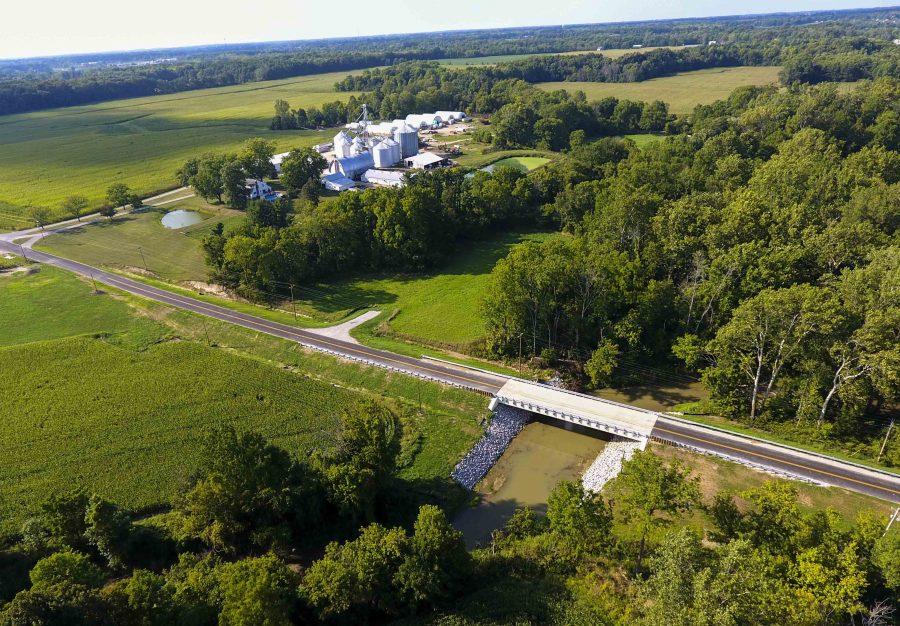Hundreds of Gallons of Fuel Leaked Into Black River
Photo by Rick Yu, Photo editor
An aerial view taken by drone of the Dechant-Notley Farms overlooking the Black River. Between 600 and 800 gallons of fuel poured into the river from the farm on Aug. 28.
September 9, 2016
Between 600 and 800 gallons of diesel fuel poured into the Black River during a spill Aug. 28, according to the Ohio Environmental Protection Agency.
Although Oberlin’s water supply is not currently contaminated, said Oberlin Water Superintendent Jerry Hade, the city is still reckoning with the aftermath.
Hade said that the spill occurred because of a failure to turn off a fuel-tank value during filling at the Dechant-Notley Farms, near West and Hughes Road in the neighboring Pittsfield Township. While Oberlin regularly uses water from Black River, no water was being pumped at the time of the spill, according to Hade. Still, he added that pumping would be suspended for two weeks “to be sure no diesel fuel would enter the reservoir, treatment plant or distribution system.”
Since the city’s water supplies remain safe, Oberlin Public Works Director Jeff Baumann went so far as to describe the spill as a “non-issue” to the Oberlin News-Tribune.
However, Community Environmental Legal Defense Fund’s Ohio Organizer Tish O’Dell disagreed.
“Saying it’s only six to eight hundred gallons and saying it’s a ‘non issue’ gives the reader the perception it’s no big deal,” O’Dell said, explaining that these spills often accumulate in small amounts and appear harmless at first, but eventually add up and cause significant harm.
“The [Environmental Protection Agency] comes out and estimates the amount of oil spilled and it’s the same thing— ‘no big deal’ — but it is a big deal,” O’Dell added. “The Ohio River has been the most polluted river in the United Sates for seven years in a row. We can’t swim in it, and we have no life in it anymore, and we can’t drink out of it.”
Although Oberlin’s water supply is safe from the oil spill pollution, it’s unclear how the spill is affecting surrounding towns and communities that also source their water from the Black River.
On Tuesday, the river still stank of oil more than a week after the spill, according to College junior Rick Yu.
And while the free product recovery was completed by the Ohio EPA on Friday, cleanup crews are continuing “to work on removing residual fuel from the remaining impacted areas,” OEPA spokesperson Lindey Amer said.
“There is still more work to do to address the source area of the spill,” Amer said. “Once the work is complete, Ohio EPA’s emergency operations will address cost recovery and violations that occurred.”
Chemtron Corporation, based out of Avon Lake, is providing environmental services for the cleanup, according to Hade. Two types of booms have been used to absorb oil in the river water. One is of floating absorbent material that collects any diesel fuel on the surface of the water. The other is a floating barrier made of plastic material with weights that diverts the spill to an area that can be pumped and hauled away for disposal. These booms were placed in several locations downstream from the spill. There is also one in front of the site of Oberlin’s river water intake.
Hade said that samples of river water will be taken by the OEPA over the next two weeks and will be tested for petroleum hydrocarbons, which will indicate whether oil is still present in the water. Once the OEPA notifies Oberlin’s water treatment plant, the city will be able to pump water from the Black River back into the reservoir.
In the meantime, Oberlin’s water treatment plant will continue to process 2.25 million gallons of water per day with water that comes from Oberlin’s reservoir, serving about 3,000 homes and businesses. The city’s water lines stretch about 40 miles.
















